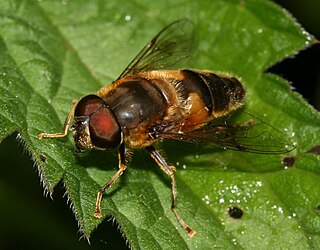
Eristalis pertinax is a European hoverfly. Like Eristalis tenax, the larva of E. pertinax is a rat-tailed maggot and lives in drainage ditches, pools around manure piles, sewage, and similar places containing water with high organic load and low oxygen concentration.

Eristalis arbustorum, the European drone fly, is an abundant Northern Hemisphere species of syrphid fly, originally officially described by Linnaeus in 1758 as Musca arbustorum. The name "drone fly" is related to its similar appearance to the drone of the honeybee. Hoverflies get their names from the ability to remain nearly motionless while in flight. The adults are also known as flower flies as they are commonly found on and around flowers from which they get both energy-giving nectar and protein rich pollen. The larvae are aquatic filter-feeders of the long-tailed type.

Eristalis nemorum is a species of hoverfly. It is found in the Palearctic and in the Nearctic.
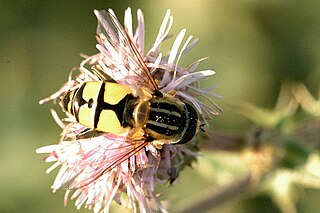
Helophilus hybridus is a hoverfly. It is a Palearctic species.
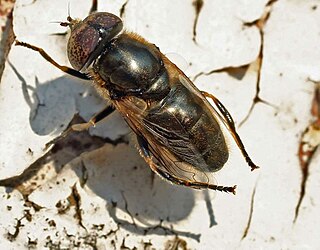
Eristalinus sepulchralis is a European species of hoverfly. The species are brownish-white from a close up, and look like a wasp. From a distance though, they are yellowish-black coloured, and look like a bumble bee. The species can be found throughout Europe in the Baltic states, North Europe, Central, Southern and Western Europe and across the Palaearctic to Kamchatka, Japan, China and India. Finland, Great Britain, Hungary, Ireland, Norway, and the Netherlands.

Eristalis intricaria is a European species of hoverfly. It is a furry bee mimic, superficially resembling Merodon, though Merodon have all black leg tibiae, as opposed to partly yellow. E. intricaria is somewhat variable in colour pattern, and some attempts at naming varieties have been tentatively made. Flight time of adults in the UK are from March to September. It is generally widespread, but is seldom seen in large numbers. Habitat is woodland or marshland.

Dasysyrphus venustus is a Holarctic species of hoverfly.
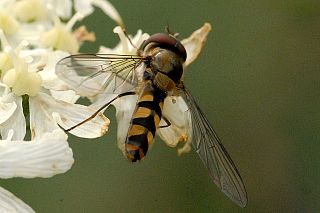
Meliscaeva auricollis is a West Palearctic species of hoverfly.

Parasyrphus annulatus is a Palearctic species of hoverfly.
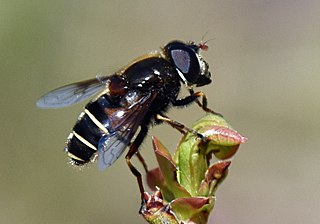
Eristalis cryptarum is a holarctic species of hoverfly. Known as the bog hoverfly or bog-dwelling drone fly, it is a bog specialist but may occur in other wetlands. Its larvae are assumed to live in peat that is saturated with water, such as that found in these boggy areas. The female has been observed depositing eggs on and close to very fresh cow dung along oligotrophic seepages in moorland.

Epistrophe grossulariae is a Holarctic species of hoverfly.

Cheilosia bergenstammi is a widespread European species of hoverfly. Adults can be found in summer visiting ragwort flowers and this plant is also the larval hostplant.
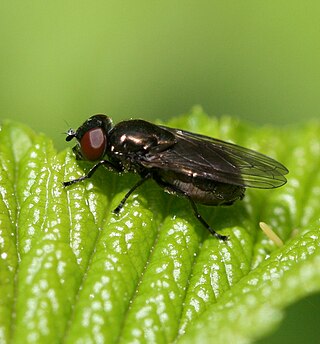
Melanogaster hirtella is a European species of hoverfly.
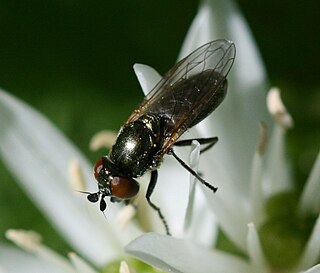
Lejogaster metallina is a Palearctic species of hoverfly.

Parasyrphus vittiger is a species of hoverfly, from the family Syrphidae, in the order Diptera.
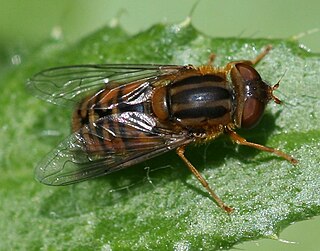
Parhelophilus versicolor is a European hoverfly.

Anasimyia lineata is a Palaearctic species of hoverfly.
Melangyna arctica is a Holarctic species of hoverfly.
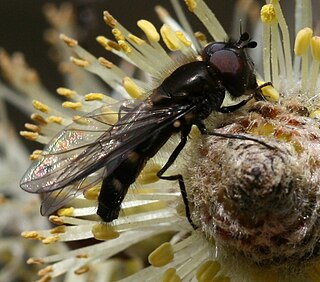
Melangyna quadrimaculata is a European species of hoverfly.

Epistrophe nitidicollis is a European and North American species of hoverfly.




















